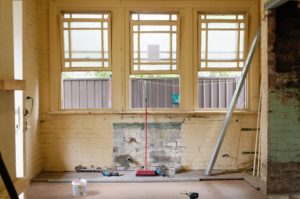Radiator Removal
Steam Heat in NYC
Radiator removal in New York City is one of the most common apartment modifications and it’s not difficult to understand why. If you’ve ever lived in a pre-war building, you’re probably familiar with steam heat. It’s hard to believe in the 10,000 years since man tamed fire, this is the best way to keep warm during winter. The qualities of steam heating system are unmistakable:
- Predictably unpredictable clanking in the wee hours of night
- Hissing sounds reminiscent of a pit of venomous cobras
- An apartment so overheated that the rain, sleet, snow and sub-zero temperatures outside start to look refreshing
- Radiators covered in rust and peeling paint that don’t exactly jive with modern interior design.
- Little-to-no ability to control the temperature
- A bulky piece of equipment that’s always in the way
We know what you’re next question is. “How do I replace it?”
The bad news is it’s no small feat. The good news is when it comes to controlling climate, humanity has taken a giant leap forward in recent years.
New York City Steam System
Why does removing a radiator involve so much work? You have to understand just how extensive New York’s steam system really is. This isn’t just a matter of taking out an old unit and putting in a new one. It’s not even a matter of disconnecting from your building’s system and opting for a self-contained heating system. The steam heating system in New York is city-wide and has been in use for well over a century. The system was literally built-into many of the city’s older buildings.
Try to wrap your head around this. New York’s steam system stretches from Battery Park all the way up to 96th Street. Pumps located strategically throughout the city funnel 24 billion pounds of steam every year. That heat is siphoned off to over 1,700 buildings all over the island of Manhattan.
When you remove a radiator, you’re disconnecting from an antiquated system that was once the lifeblood of the entire city.
Removing a Cast Iron Radiator
Taking out a radiator isn’t just an odd job–it’s a renovation. Cast iron is one of the heaviest construction materials. A single radiator usually weighs upwards of four-hundred pounds. That alone makes it a two-to-three person job before you even factor-in the expertise required to do it properly.
Because this kind of work is classified as “home renovation,” you’ll need to secure the necessary approval before the work starts. If you own your building or apartment outright, you likely won’t have to worry about getting further approvals. But if your building is run by a larger body like a management company or co-op board, you’ll need to go through the appropriate channels first. Each building has its own policy when it comes to radiator removal and they’ve likely dealt with this kind of request before. If taking out the radiator is part of a larger renovation project, be sure to include specific plans for the radiator in the broader renovation proposal.
The pipes connecting your building’s system to your radiator need to be “cut” and “capped.” If done incorrectly, it can seriously affect your home’s re-sale value and be very expensive to fix. Once your approvals are in order, do not cut corners when deciding on a contractor. A company with experience and insurance coverage should be at an absolute premium. In fact, much of the radiator work Stanley Ruth does is to correct incorrect or poorly done work by previous contractors who might not be as well-versed in pre-war and landmark apartments.
After your Cast Iron Radiator is Gone
So what do you replace your radiator with? There are a wide range of options available to the modern consumer. One of the most popular and effective options for property owners in New York City is the through-the-wall HVAC or PTAC system.
When you hear the word “HVAC,” you probably think of a run-of-the mill air conditioner. But as innovators in the field, Stanley Ruth developed a way to modify an HVAC unit so it can connect your building’s pre-existing steam heating system. In effect, this gives you access to all of the perk(s) of a steam heating system (ie the power) and none of the irritating pitfalls. Once the HVAC unit is installed and modified, you can actually manipulate your home’s heat with the same degree of control you do with air conditioning.
How is this Done?
As we mentioned before, your contractors will remove your cast iron radiator by cutting the connective piping that attaches to your building-wide system. Instead of “capping off” the ends of the pipes, a technician can actually attach an HVAC unit to the steam pipes that once connected to your radiator. This process, called “pipe-fitting,” affords homeowners the ability to fully control the temperature–and comfort–within their own homes.

